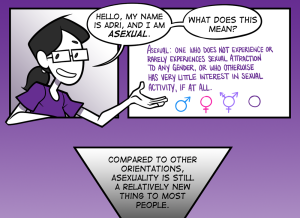I am Latina, I am Latina, I am Latina.
I feel as though I must reaffirm this to myself in order to truly believe it is my identity. Why?
Because everything I see and have always seen about what it means to be Latina bears no resemblance to the way I look and the personality I present.
Not only are my sexuality, the way I speak, and the way I dress not in alignment with the “Spicy Latina” stereotype, but my skin color and tight curls are also characteristics that tempt people to question my Latinidad.
I find myself fighting hard to validate my level of Latinidad to people who don’t even know the difference between Mexican and Puerto Rican and really don’t care to learn.
Too recently I have been subjected to the following comments when answering the question of my ethnicity: “Wow, really? Like you are 100% Puerto Rican, or just half?” “You don’t really look Puerto Rican.” “But, you don’t even have an accent.” And my favorite, “Say something in Spanish!” Or even worse, “Say something in Puerto Rican!”
Often times I find myself saying, “My mom is Puerto Rican, that’s why I’m so lively and colorful,” with the same enthusiasm as April Ludgate from Parks and Rec.
Seriously though, this stereotype and the clumping of all Latinas into one massive bowl of sameness doused with way too much extra spicy hot sauce is a real problem.
It objectifies us and it makes our multidimensional awesomeness invisible to society and to ourselves. Especially when we attempt to drown out our individuality in order to fit neatly into the “Spicy Latina” box everyone is so accustomed to.
This stereotype is so pervasive and ingrained into our perception of Latina identity that I don’t doubt we have all been exposed to it. But do we know how it came to be what it is today? Can we point out its characteristics?
To better understand why this stereotype is so fucked up we must first unpack its history and the ways it has manifested itself in our everyday lives.
The Fucked Up History of Latinx Marginalization
So how exactly did the spicy Latina stereotype form? To answer this question, we have to go back to 1846 during the Mexican-American War. I know it seems far-fetched to go this far back, but hear me out because there is a connection here.
The Mexican-American War was a struggle against further American expansion into Mexican territory and although political divisions within Mexico led to an American victory, the consequences of this war extend much further than the loss of land.
The most powerful weapons utilized in war are manipulation and racist ideology and this war was no different.
These weapons, Manifest Destiny in particular, helped justify invasion and violence. Although to the American people invasion seemed best for all, it was really only best for them.
Basically, Manifest Destiny sucks like hell if you’re deemed the inferior group.
As the dominant group, Americans had the power and the resources to influence public perceptions of the Mexican people. Journalist and content creators painted Mexicans as a lazy, corrupt, and disappearing people.
So what did this control of public perception lead to? What it always leads to, erasure and major oppression. The blurring of Mexican identity and experiences allowed room for the formation of stereotypes, like the spicy Latina, that continue to group all Latin American people together to this day.
Creating the Image of Chiquita Banana and Other Fucked Up Media Representations
In the past, the portrayal of Latinx people in media has been offensive at best. This is something Latin American countries are not oblivious to.
In fact, Mexico called for an embargo of US films in 1922 because of the messed up image these films painted of Mexican culture. In 1933, this portrayal changed slightly. To be honest, the new image still had major issues, it was just serving a different agenda.
In 1933 President Franklin Roosevelt announced his foreign policy plan. The Good Neighbor Policy did succeed in making Latin America and the US friendlier neighbors.
This temporary peace was beneficial for Latin America because it made sure the US stayed out of Latin America’s business, helped them out economically through filmmaking that promoted tourism, and created more opportunities for work in Hollywood. Sounds like a sweet deal, right? Sure, except for not really.
See, the US needed Latin America on their side during WWII to prevent the spread of communism. Talk about alternative motives. So, yes they did help them out with filmmaking and propaganda that promoted tourism.
The problem was that this new image replaced negative stereotypes with more (although friendlier) stereotypes. This new image was still not true to the diversity and unique cultures of Latin American countries.
One of the most popular icons that emerged from this policy was the Brazilian dancer, Carmen Miranda.
This Brazilian Bombshell was the spicy Latina stereotype personified with her exotic Latin accent and emblematic fruit hat. She lives on to this day as the perfect example of “Tropicalism,” or the portrayal of Latin Americans as exotic, fun, and friendly foreigners.
She was so much the symbol of Latin culture that the United Fruit Company created Chiquita Banana, a cartoon character whose resemblance to Carmen Miranda was no coincidence, to represent their company.
Recognizing Latina Characters Disguised as Spicy Food
So what exactly does the spicy Latina look like?
Let’s start with the physical aspects. A simple Google image search will conjure up images of olive skinned, raven haired, red lipped, curvaceous women. And it’s no surprise that the first image is that of Carmen Miranda, the epitome of the spicy Latina herself.
My eyes quickly shift to a colorful image of a pulp fiction novel titled Spicy Adventures: She Devil featuring a scantily clad, olive skinned, raven haired, red lipped, curvaceous woman.
Then there is a picture of actress Michelle Rodriguez seductively holding a gun, a picture of actress Sofia Vergara on the cover of Esquire magazine with the word “sex” emblazoned over her lower half, and a picture of a spicy chicken sandwich next to an image of a Saturday Night Live character portraying a Latina woman.
Most other images are of women with skin-tight clothes, light skin, and straight or wavy hair.
According to this search, Latinas are synonymous with sex and spicy food.
What about personality, you might be asking?
A spicy Latina must be loud, bombastic, and seductive (insert sexy Latin accent here). She must also be hot-blooded, quick-tempered, and passionate. Think Gloria from Modern Family, or Gabrielle from Desperate Housewives, or Eva Mendes in…well, everything.
In fact, think of any Latina character in the media and chances are if she is not portraying a feisty maid, she is portraying a spicy Latina.
Although objects of desire for many, the spicy Latina may have too much personality to handle. So much so that she is often viewed as domineering or emasculating. This positions the man as a bullfighter who is applauded if he succeeds in taming and conquering the bull.
Of course, the main appeal of the spicy Latina is her sexuality.
A spicy Latina is extremely sexy. She is lustful, promiscuous, and tempting. She is also very clearly heterosexual.
These dangerous and irresistible vixens use their physical assets to lure and catch their mates. If they can’t bait you with their bodies, then they will tempt you with their food. Spicy Latina’s know the way to a man’s heart is through his stomach.
Spicy Latinas don’t just love sex and want to have it all the time. Spicy Latinas are sex. Once they have trapped you, they will fulfill all of your sexual desires because spicy Latinas are willing to do anything to make you happy.
After all, spicy Latinas exist only for your pleasure and entertainment needs.
Why the Spicy Latina Stereotype Is Fucked Up
So why is this image so fucked up? I mean, there are worse things to be associated with than sexy, beautiful, and passionate – right?
Let me explain.
Being called a spicy Latina is like being called a delicious spicy chicken burger.
I have certain expectations when it comes to my spicy chicken burgers and I will be highly disappointed if those expectations are not met.
The problem, if it’s not obvious yet, is that Latinas are not food! I am not juicy, I am not a hot tamale, and I am definitely not spicy. Without going around and asking permission to taste the Latina women I know, I think it’s safe to say that none of them are spicy either.
It’s wonderful to be thought of as sexy, beautiful, and passionate, except for when you don’t have a choice.
The problem with the spicy Latina stereotype is that it generalizes Latina identity and doesn’t allow for much room to form an individual and authentic self. This over generalization of Latinidad makes it hard for Latina women to see themselves as anything but what others expect.
It is a form of oppression that aims to limit potential through the internalization of an image created by a society that does not understand the varying cultures of Latin Americans.
This exoticism and fetishizing of Latina women’s bodies transforms them into mere objects. They become less human and more like prizes to be won and showcased. Although there has been some improvement (Ugly Betty and Jane the Virgin), there is still a huge issue with typecasting in Hollywood.
When the only roles Latina actresses have available to them are the spicy Latina or sassy maid, then that is all the public sees and all the public expects.
These are the role models available for Latina girls and if their role models are never the main characters, never the doctors, never the teachers, and never worth more than their sex appeal, then young Latinas will rarely ever aim for those goals.
Two of the most important reasons why the spicy Latina stereotype is so fucked up have to do with race and sexuality. As a Latina, I am aware that we don’t all look the same like we do in the media.
There are different races even within Latin America (shocking, I know). Yet, I find myself having to explain that although my skin is darker than my sister’s skin, that doesn’t mean I am any less Latina. Just because my hair is big and curly and not at all like Jennifer Lopez’s hair doesn’t mean you get to question my honesty when I tell you I am 100% Puerto Rican.
This exclusion of Afro-Latina women in our society is painfully obvious to me because the way I look doesn’t scream Latina and because I rarely see Latina women, “spicy” or otherwise, who look like me in the media.
Moving on to sexuality.
What if you are a Latina who does not identify as heterosexual? What if you identify as lesbian, or bisexual, or asexual? Sorry, you do not fit into the spicy Latina box.
As mentioned earlier, one of the most prominent characteristics of the spicy Latina stereotype is her sexuality or more specifically, her heterosexuality. This is coupled with reproductive pressure and the belief that all Latina women are or will someday be mothers because they are too sexually promiscuous not to be.
As a bisexual identifying Latina woman, I resent this.
It took me so long to finally accept my sexuality because everything I saw about what it meant to be Latina told me I should be attracted to men only, told me I should dress for men only, told me my ambitions in life should ultimately lead to motherhood.
I’m not saying there is anything wrong with being any of these things, as long as you are happy and don’t feel you are betraying your own identity. But, unfortunately, it’s not like that at all for entirely too many of us.
The spicy Latina stereotype is fucked up for so many reasons, but the saddest part is that everyone else thinks they have the authority to decide if you are Latina enough for them.
Truth is, I am Latina enough for me, and I don’t need anyone’s permission to be.
[do_widget id=’text-101′]
Katherine Garcia is a Contributing Writer for Everyday Feminism. She is a recent college graduate with a BA in Radio, TV, Film and soon to be graduate school student pursuing a Masters in Women and Gender Studies. She is passionate about LGBTQIA+ rights, domestic violence advocacy, Latinx issues, and mental health awareness, as well as 80s hair metal, used book stores, astrology, and chocolate. You can follow her on Twitter @TheLazyVegan1.
Search our 3000+ articles!
Read our articles about:
Our online racial justice training
Used by hundreds of universities, non-profits, and businesses.
Click to learn more





















